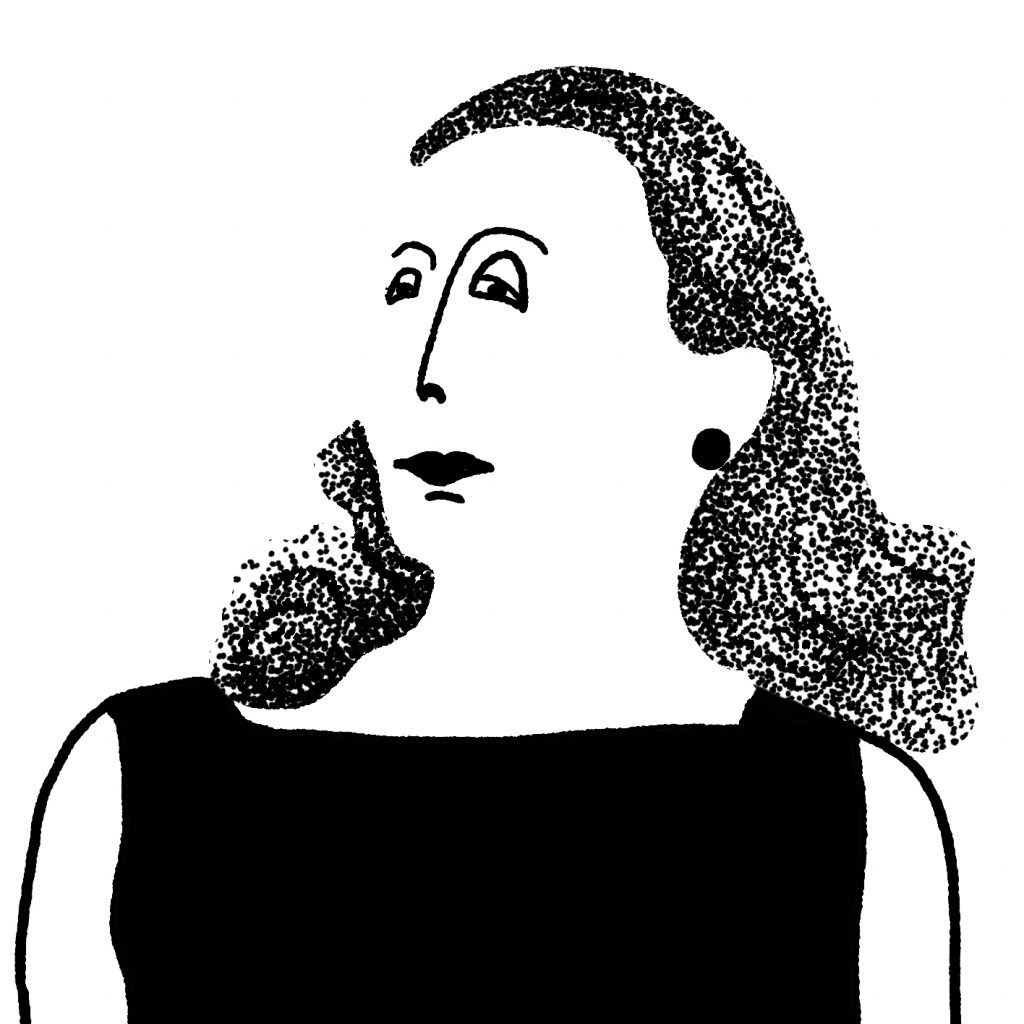
TAMARA ŁEMPICKA 1898 – 1980
WOMAN IN GREEN BUGATTI 1929
oil on wooden board, 35 x 27 cm
„Among hundreds of paintings, you could easily recognize mine.“
The painting was created on commission of the German fashion magazine Die Dame.
When the magazine’s publisher saw the extraordinary beauty near a casino in Monte Carlo, he asked Łempicka to pose for the magazine’s cover. Łempicka offered to paint her self-portrait instead. The exceptionally elegant artist created her own image. She allowed to be photographed only from one profile, the one shown in the self-portrait. Art historians see Łempicka’s Self-portrait as a representative symbol of art deco aesthetics. In her easily recognizable style, the artist brought together classical (renaissance) aesthetics and modern cubistic forms. The painted surfaces produce a metallic sheen and look as if they were polished.
Tamara Gurwik-Górska was born in 1898 most probably in Moscow although she used to name Warsaw as her birthplace. Her mother was Polish while her father was a Russian entrepreneur of Jewish origins. In 1916 she married Tadeusz Łempicki. In 1918 to escape the revolution the couple left for Paris. There the artist took up painting lessons and had her first exhibition. Soon a craze for Łempicka’s works swept among affluent aristocracy and bourgeoisie. The artist used to portray them as sensual deities transferred to the times of jazz and foxtrot. Before her 28th birthday Łempicka earned a million dollars from her paintings. She was called ‚la belle Polonaise‘ (‘the Polish beauty’). Her career was cut short by the outbreak of World War II. She escaped to the USA, where her art did not catch on. Her works were associated with banality. Łempicka was still popular but more for her exclusive and extravagant lifestyle rather than her art. In 1978 she moved to Mexico, where she died in 1980. Łempicka’s art was recognized again in the 1970s.
Today her paintings reach exorbitant prices, much higher than any other Polish artist’s. Łempicka’s paintings are to be found among collections of such Hollywood celebrities as Barbra Streisand, Jack Nicholson and Madonna.
Illustrated by ŁUKASZ ZBIERANOWSKI / FAJNE CHŁOPAKI

WŁADYSŁAW STRZEMIŃSKI 1893 – 1952
AFTERIMAGE OF LIGHT: Redhead
oil on canvas, 55 x 82 cm
„Looking is not the same as seeing. Facing the same view, medieval peasants and the 19th century proletarians would look at the same thing but see something different.“
Władysław Strzemiński was a painter and art theoretician, who analysed the mechanisms behind vision and perception. An afterimage is an optical phenomenon produced by the anatomy of the retina. The light leaves a trace – an afterimage – inside the eye. It is easy to experience it when gazing at a source of light, the sun or a light bulb, for a few seconds and closing your eyes. The redhead from the painting is said to be Hanka Orzechowska, one of Strzemiński’s students, who the painter had an affair with. Afterimage is also the title of Andrzej Wajda’s film about the final years of Strzemiński’s life. The artist was portrayed by Bogusław Linda. Although he lost an arm and a leg, Strzemiński enjoyed popularity among women. His disability is not to be seen on photographs. He is usually sitting or standing behind someone hiding his crutches or masking the missing arm with a loose sleeve tucked into a pocket.
Strzemiński was born into a Polish family in Mińsk (a territory occupied by the Russians). As his father was an officer in the Tzar’s army, it was apparent that Władysław would serve in the military as well. During the war, he lost one arm, a leg, and vision in one eye. It was in a hospital where he met a young volunteer and his future wife, Katarzyna Kobro. They escaped Russia in 1922 and settled down in the Polish city of Łódź. They both made a living mostly as teachers. After the war Strzemiński participated in the creation of the Academy of Fine Arts in Łódź, where he worked until 1950. In that year, he was expelled from the institution being accused of disrespecting the standards of the social realism doctrine. Deprived of a source of income, the artist worked as a window display designer. As he was getting weaker with hunger, his health started deteriorating. He died of tuberculosis in hospital.
Strzemiński and his wife belonged to the world’s elite of avant-garde artists, which allowed the painter to create an international collection of modern art. His collection provided a foundation for the Art Museum in Łódź – the second institution with this type of collection in the world following the MOMA in New York.
Illustrated by ŁUKASZ ZBIERANOWSKI / FAJNE CHŁOPAKI

ANDRZEJ WRÓBLEWSKI 1927 – 1957
EXECUTION VIII SURREALE 1949
oil on canvas, 130 x 199 cm
„A painting is a voice that talks about the important, terrifying, and depressing issues. The painting wants to portray what can’t be portrayed, and to comprehend death, which is beyond comprehension.“
The painting belongs to a series of eight paintings addressing the same theme of Execution. They were numbered by the artist’s mother while preparing the painter’s posthumous exhibition. She misarranged their chronological order, though. While painting Executions, Wróblewski used authentic Nazi propaganda photographs of mass street executions from 1939. Blue is the colour of death for Wróblewski as it evokes the temperature of a decaying body. When asked by his friend, Andrzej Wajda, why he painted all of the dead bodies blue, the artist ironically answered that he had a large and highly efficient tube of Prussian blue. Wróblewski did not enjoy engaging in conversations about his own art, making confessions or sharing personal stories.
Andrzej Wróblewski inherited his artistic talent from his mother, an artist herself, and his first teacher. He was a witness to his father’s death of, most probably, a heart attack during a search by Nazi soldiers in 1941. It came as a tremendous shock for a fourteen-year-old boy. Throughout his life, the artist was looking for a way to express his trauma and horrors of the war. In his youth Wróblewski developed a fascination for communism, which he believed would be a cure for injustice and fascism. Even though he was willing to follow the aesthetics of social realism, the artist did not gain the acceptance of the ruling party. He, his wife and three children lived in poverty. The painter died suddenly during an excursion to the Tatra mountains, at the age of nearly 30. Most probably he suffered from an attack of epilepsy. He found was sitting under a tree on a trail to Morskie Oko Lake, with his skull shattered.
Wróblewski has had a considerable impact on subsequent generations of Polish artists. However, it took a long time before his art won international acclaim. The painter’s first individual exhibition aboard was organized no earlier than fifty years after his death. Following several international events, Wróblewski’s name is now listed along such giants of the 20th century painting as Pollock or Rothko.
Illustrated by ŁUKASZ ZBIERANOWSKI / FAJNE CHŁOPAKI

WILHELM SASNAL 1972
THE FOREST (SHOAH) 2002
oil on canvas, 45 x 45 cm
„My mind is unable to create fiction. My art is always grounded in reality.“
A small square covered in a whirl of green and white paint. It takes a closer look at the painting to recognize what it represents. In his art, Sasnal never employs fiction and rarely turns to abstract representations. Depicting a real scene, The Forest is a painting with a key. In his early career following the graduation from the Academy of Fine Arts in Kraków, Sasnal was completely obsessed with the Holocaust. As a result, he created a series of paintings exploring this theme. His work often resembles film scenes. The same is true about The Forest, which is a direct reference to Claude Lanzmann’s film Shoah. The painting shows the moment when the director, an interpreter and the Shoah witness are discussing the war experiences walking in the forest near the former death camp in Treblinka.
Wilhelm Sasnal has been developing his art projects in the field of painting and for over a decade film. When as a student Sasnal belonged to a group of artists called Grupa Ładnie, the Polish critics nicknamed him a “pop-banalist.” For Sansal, anything could provide the impulse behind the creation of a painting be it an overheard conversation, a historic event, or his own life experience. The artist is often inspired by photography, media, and press. One of the artists that have had a significant impact on his art is a painter, Andrzej Wróblewski.
The year of 2002 marked the start of the artist’s international recognition. The breakthrough came when the Warsaw-based art gallery, Foksal Gallery Foundation, displayed the artist’s works during the most renowned art fair in the world, Art Basel, in Switzerland. There, the artist achieved an unprecedented success. All his paintings were sold out and all major art magazines featured articles about the painter. Since then, Sasnal’s art has been exhibited all over the world and his paintings are included in the collections of the most significant art institutions.
Illustrated by ŁUKASZ ZBIERANOWSKI / FAJNE CHŁOPAKI
